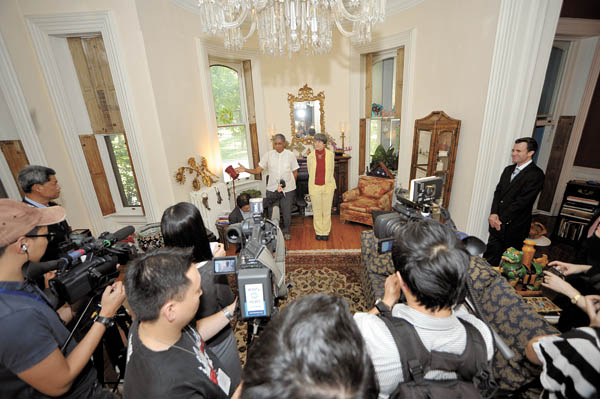Key site in Korean history to be revitalized

The building in Washington, D.C., that served as the Korean legation in the United States from 1891 to 1910 will be restored in September of next year. The Taekgeuk symbol and four trigrams on the entrance, in the left photo, the tiger skin in the reception room, in the middle, and the national flag in the lobby, in the right photo, will return. [OVERSEAS KOREAN CULTURAL HERITAGE FOUNDATION]
A reddish-brown three-story Victorian building in the Logan Circle Historic District of Washington was used as the Korean legation in the United States from 1891 until 1910.
It opened as Korea was determined to tell the world that it was a viable, independent state that did not want to be ruled by its neighbors, particularly Japan. Those attempts, however, failed, and Japanese colonization began in 1910.
Soon, the Taegeuk symbol and four black trigrams that were carved on the building’s entrance will return, and the national flag that also bears the symbols will be hung in the lobby once again - just as it did in a 1893 photo of the building.

In this 2012 file photo, Timothy L. Jenkins, a U.S. lawyer who bought the building in 1977 and had lived there since, talks to reporters after he sold it to the Korean government. [CULTURAL HERITAGE ADMINISTRATION]
“We will do our best to restore the building to its original shape based on historical materials we’ve discovered,” Oh Su-dong, secretary general of the Overseas Korean Cultural Heritage Foundation, told reporters last month. “We believe doing so is the best way to highlight Korea’s conviction for independence.”
In particular, the national flag, or Taegeukgi, that was hung in the lobby of the building has been recreated. “We made a flag in the exact same style as in the 1893 photo, embroidered entirely by hand, stitch by stitch,” Oh said. The tiger skin that decorated the reception room will also be back, except replaced with an artificial tiger skin.
While the officials at the foundation and academics have secured enough photographs and documents detailing what the first and second floors looked like, they haven’t been able to find any information on the third floor. As a result, officials at the foundation have decided to use the third floor as a display area for exhibitions.
“We are lucky because former owners of the building have kept the original structure of the building’s interior and exterior,” Oh said.
Kim Jong-hun, an architecture professor at Pai Chai University in Daejeon, who inspected the building in 2012 when the Korean government bought the building, also said, “Compared with the photos from the past, the space and structure is almost perfectly preserved.”
The building is, in fact, the only former overseas establishment set up during the late years of the Joseon Dynasty (1392-1910) that has retained its original shape.
Still relevant
Gojong (1852-1919), the last king of the Joseon Dynasty and first Emperor of the Korean Empire (1897-1910), dispatched Park Jeong-yang (1841-1904) as Korea’s resident minister plenipotentiary in the United States in 1887, defying pressure from Japan and China.
Korean diplomats initially worked from rented quarters. But Gojong decided that Korea needed a building for its diplomatic activities, and bought the property in Washington in 1891 for $25,000, a huge amount for the waning dynasty.
The amount is equivalent to $1.27 million (1.4 billion won) today.
“That Gojong opted to buy the property, not rent it, shows how determined Gojong was to show Korea’s willingness for autonomy through diplomacy,” Professor Kim said.
But the legation also shows how a weak national power with a lack of strategic diplomacy can only do so little. Although Gojong’s plan was to enlist the U.S. to help stave off the growing territorial ambitions of Japan and China toward the Korean Peninsula, the plan didn’t work due to Korea’s weak national power and an international order already established by powerful states.
The lesson is still relevant in today’s politics.
Han Jong-su, a researcher at the Overseas Korean Cultural Heritage Foundation, said, “The legation shows how strengthening national power should come first in order for strategic diplomacy amid the ongoing power struggle between the U.S. and China.”
Back home
After Japan defeated Russia in the Russo-Japanese War (1904-05), the American legation in Korea pulled out of the country. Korea had no choice but to hand over the legation in Washington to Japan.
Two months before Japan’s annexation of Korea in 1910, Japan purchased the building for the suspicious amount of $5. And two days after Japanese colonization officially began on Aug. 29, 1910, Japan sold the building to an American named Horace K. Fulton for $10.
It wasn’t until the 1980s that a few Korean scholars learned of the existence of the legation through documents in Washington. Beginning in the early 2000s, the Korean community in Washington and other opinion leaders attempted to buy back the building.
In 2012, the Korean government signed a contract to purchase the building for $3.5 million from Timothy L. Jenkins, a U.S. lawyer who bought the building in 1977 and had lived there since.
Oh said the foundation will work with other relevant institutions like Korean Embassy in Washington to utilize the building and let others know about the history of Korea and the building.
The building, just a 10-minute drive from the White House, has already been included in the 2.4-kilometer (1.5-mile) history tour course operated by the nonprofit Cultural Tourism DC since 2013.
BY CHAE BYUNG-GUN [hkim@joongang.co.kr]










with the Korea JoongAng Daily
To write comments, please log in to one of the accounts.
Standards Board Policy (0/250자)